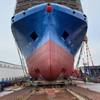Launch of First Future Destroyer, Hobart
Speech delivered by the Minister for Defence, Kevin Andrews during the launch of Hobart - the first future destroyer:
Thank you for being here on this very important day.
Today, is a significant milestone for the Air Warfare Destroyer Project, marking a big step forward towards the delivery of three highly capable warships to the Royal Australian Navy.
The launch of Hobart clears the way for progress on all three destroyers. The AWD Alliance can now focus on ship completion and system commissioning for Hobart, which will be followed by sea trials next year.
And with Hobart in the water, the second destroyer, Brisbane, can soon take its place on the hardstand to undergo final block consolidation, and the keel for the third destroyer, Sydney, will be laid.
I am pleased to see the progress since my visit to Techport Australia earlier this year, when I saw Hobart fully consolidated with substantial combat and platform systems installed.
Hobart has moved into an advanced phase of production and integration. This includes the vertical launch system, the electronic warfare antenna, all four SPY radar array faces, the sonar dome and the MK 45 gun mount.
Hobart has also become the first ship outside of the United States to have the next generation AN/SPQ-9B radar installed.
This radar will enable the Royal Australian Navy to scan out to the horizon to detect and track low flying anti-ship cruise missiles, surface threats, and low/slow flying aircraft, unmanned aerial vehicles and helicopters.
I have also had the opportunity to walk through the second destroyer Brisbane — now in an advanced state of fit-out with more than half of the blocks already consolidated on the hardstand.
So, as Hobart moves into this next phase of being launched, the second and third destroyers, Brisbane and Sydney, will benefit from the AWD Alliance applying lessons learned from the Hobart.
This progress demonstrates the ongoing commitment and effort of the AWD Alliance to improve productivity and successfully deliver three of the most capable warships ever operated by the Navy.
In December last year the Government announced its commitment to getting this important Defence project back on track and stopping the growing cost and schedule overruns.
The AWD program has benefited from the commencement of the Government-initiated AWD Reform Strategy.
During the past three months, a group of experienced shipbuilding personnel from BAE Systems and Navantia, and additional personnel from Raytheon Australia has been working within the AWD Alliance teams to provide mentoring and advice.
The Hobart has reached this milestone through Government and industry collaboration involving an Australian workforce of some 3000 highly-skilled people. This includes the AWD Alliance made up of lead shipbuilder ASC, mission systems integrator Raytheon Australia and the Department of Defence, including the Royal Australian Navy.
Navantia, as the AWD Platform System Designer has provided ongoing support and knowledge to the program, along with the capability support provided by the United States Navy and Lockheed Martin.
Considerable work has also been carried out by AWD’s many contractors, particularly block sub-contractors Forgacs, BAE Systems, Navantia and MG Engineering.
The AWD project is an example of how a skilled Australian workforce working hand-in-hand with international partners can ultimately deliver warships that will have a combination of great endurance, offensive and defensive weapons, flexibility and versatility.
The ships will be able to assume a leading command and control role within the Australian Defence Force and Coalition forces capable of carrying out multi-mission operations.
AWD is one of the largest and most complex Defence projects ever undertaken in Australia and has been instrumental in building a strong shipbuilding capability in Australia.
I sincerely thank all who have worked on the Hobart and your contribution towards this milestone.
To the shipbuilders gathered here today – I say to you – thank you.
I also wish to thank all of our industry, international and naval partners here today.
The Federal Government recognises the significant value to our nation of having a skilled naval ship building industry. We cannot afford to see this industry disappear.
The Government is prepared to invest in the skills and knowledge base of the Australian naval ship building industry, and is prepared to commit to a long-term investment to make sure this important industry enjoys a future in Australia and these critical skills are maintained.
One of the options being considered by the Government is the feasibility of a continuous build strategy. This would sustain a shipbuilding industrial base, and avoiding the peaks and troughs currently being experienced.
The Government will release an enterprise-level naval shipbuilding plan later this year, which will provide for the long-term future of the Australian naval shipbuilding industry.
To achieve this, strong and visionary leadership is required to embrace and institutionalise the changes that will lead to a shipbuilding industry that is properly structured and managed to operate effectively and drive efficiencies, and a commitment to a productivity-based culture from all parties.
I look forward to seeing the ship completion and system commissioning for Hobart and subsequent sea trials next year.
And ultimately, the delivery of all three destroyers, which will provide the next-generation capability for the Royal Australian Navy.










